Robberflies are a fascinating group of insects belonging to the family Asilidae within the order Diptera, which includes flies, mosquitoes, and gnats. These predatory insects are renowned for their striking appearance and voracious hunting behavior. Here’s a description of a typical robberfly:
Physical Characteristics: Robberflies vary in size, ranging from relatively small species measuring around half an inch (1.3 cm) in length to larger ones reaching up to 2 inches (5 cm) or more. They have a robust body with a prominent, elongated abdomen and a relatively large, rounded thorax.
One of the most distinctive features of robberflies is their remarkable resemblance to bees or wasps. This mimicry serves as a form of protective coloration, deterring potential predators from attacking them. However, upon closer inspection, their true identity becomes apparent, especially due to their characteristic wings and antennae.
Robberflies possess a pair of large, compound eyes that provide excellent vision, enabling them to spot prey from a considerable distance. Their antennae are usually short and bristled, aiding in sensory perception.
Habitat and Behavior: Robberflies can be found in various habitats worldwide, including forests, grasslands, meadows, and even urban areas. They are often encountered perched on vegetation or other elevated vantage points, where they patiently wait for potential prey to pass by.
Despite their small size, robberflies are formidable predators. They primarily feed on other insects, including flies, bees, beetles, and even butterflies. Using their exceptional agility and lightning-fast reflexes, they ambush their prey in mid-air, capturing them with their powerful, needle-like mouthparts known as a proboscis.
Once a robberfly has seized its victim, it injects them with a potent cocktail of enzymes that quickly immobilizes and liquefies their internal tissues. The robberfly then proceeds to suck up the liquefied contents, leaving behind an empty exoskeleton.
Ecological Role: Robberflies play a crucial role in controlling insect populations, particularly those of pest species. By preying on a wide range of insects, they help maintain ecological balance and contribute to the overall health of ecosystems.
In addition to their ecological significance, robberflies also serve as indicators of environmental quality. Their presence in an area is often indicative of a healthy and diverse insect community.
In conclusion, robberflies are remarkable insects renowned for their predatory prowess and striking appearance. Despite their relatively inconspicuous size, they play a significant role in ecosystems and are a testament to the intricacies of nature’s design.
Views: 970
Subscribe to the newsletter:
